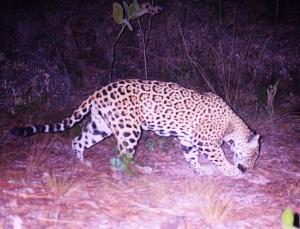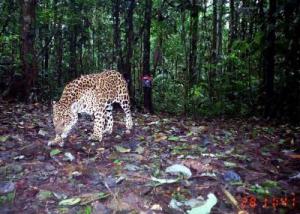First Central Mexican Jaguar In 100 Years
Posted by: Loren Coleman on February 11th, 2009

One of the three photographs of the jaguar taken during the research project in the center of Mexico. (Credit: Octavio Monroy-Vilchis et al / SINC)
The jaguar Panthera onca has become an animal in danger of extinction over recent decades, due to the fragmentation and deterioration of its habitat, as well as hunting and illegal animal smuggling.
In one recent survey, positive results were found in Ecuador. Now good news has surfaced from Mexico.

A jaguar recently captured in a camera trap in Ecuador. (Credit: Santiago Espinosa)
As a result of this vulnerability, no individuals have been seen in the center of Mexico since the start of the 20th Century. However, Mexican and Spanish scientists have now managed to photograph a male jaguar in this region.
The lack of published records about the jaguar Panthera onca in the State of Mexico and concerns about whether this animal may have become extinct in the forests of the 674.10 km2 Sierra Nanchititla Natural Reserve led to researchers from the Autonomous University of the State of Mexico (UAEM) and the University of Alicante (UA) successfully seeking out and monitoring this feline.
The Mexican-Spanish research project, which has been published recently in The Southwestern Naturalist, includes the first documented recording of Panthera onca in the center of Mexico, in the Río Balsas river basin.
“The photographs provide information about new recording sites, and allow us to deduce that the area where the animal was observed may be a corridor connecting jaguar populations,” Octavio Monroy-Vilchis, lead author and a researcher at the UAEM, tells SINC.
The researchers carried out 86 interviews with inhabitants of villages near the study area between October 2002 and December 2004, as well as collecting feline dropping samples and installing automatic photographic detection systems.
“Even though not one of the interviews mentioned sightings of jaguars, we obtained three photographs of a male, and ten of the 132 excrement samples found have been attributed to the jaguar,” says Monroy-Vilchis.
According to members of the local Wildlife Conservation Society, the general area of the Río Balsas river basin is a priority area for verifying the presence of jaguars, since this “could act as a corridor for them to move around.”
The experts say there are 15 areas in which it is unknown whether these animals still exist, whether their populations are stable, and if their habitat is adequate. These areas are important for scientific studies, because they could include crucial zones for the felines’ long-term survival.
The jaguar’s habitat, a limited territory
Monitoring the largest feline in the Americas in the center of Mexico meant the Mexican scientists had to travel 1,360 kilometres in search of clues and footprints. The Spanish researchers financed the cameras and analyzed a total of 1,800 data events collected by them, which were placed in the Natural Reserve.
Of all this material, only three photographs deposited with the image library of mammals in the Sierra Nanchititla Biological Station (UAEM) showed a male individual.
Despite the photographs taken, the researchers themselves were unable to see the animal.
“The lack of evidence highlights the fact that the jaguar is more elusive than other felines, and that its presence in the area is sporadic – possibly because it has access to other resources near to Michoacán and Guerrero,” says Monroy-Vilchis.
The recording of this individual and the presence of excrement in a range of sites in the south east of the State of Mexico now mean its known range has been extended to 400 km to the south east of Arroyo Seco (Querétano), 27 km to the north east of Purísima de Arista, and 140 km to the north of Puerto del Gallo (Guerrero).
According to the scientists, the fact that the animal was captured on film at 1,845 metres “supports the theory that jaguars travel along the sides of mountains because their habitat has been fragmented by hunting and other human activities,” says the scientist.
Bibliographic information: Monroy-Vilchis, O; Sánchez, O; Aguilera-Reyes, U; Suárez, P; Urios, V. “Jaguar (Panthera onca) in the State of Mexico” Southwestern Naturalist, 53(4): 533-537 diciembre de 2008.
About Loren Coleman
Loren Coleman is one of the world’s leading cryptozoologists, some say “the” leading living cryptozoologist. Certainly, he is acknowledged as the current living American researcher and writer who has most popularized cryptozoology in the late 20th and early 21st centuries.
Starting his fieldwork and investigations in 1960, after traveling and trekking extensively in pursuit of cryptozoological mysteries, Coleman began writing to share his experiences in 1969. An honorary member of Ivan T. Sanderson’s Society for the Investigation of the Unexplained in the 1970s, Coleman has been bestowed with similar honorary memberships of the North Idaho College Cryptozoology Club in 1983, and in subsequent years, that of the British Columbia Scientific Cryptozoology Club, CryptoSafari International, and other international organizations. He was also a Life Member and Benefactor of the International Society of Cryptozoology (now-defunct).
Loren Coleman’s daily blog, as a member of the Cryptomundo Team, served as an ongoing avenue of communication for the ever-growing body of cryptozoo news from 2005 through 2013. He returned as an infrequent contributor beginning Halloween week of 2015.
Coleman is the founder in 2003, and current director of the International Cryptozoology Museum in Portland, Maine.










Nature on the rebound, this is great news.
Good find, and it’s nice to not hear “released pet”.
You might want to collect more data on this, The cat has been seen in New Mexico a few years ago and parts of West Texas as recent as 2-5 years ago.
t
A very thorough abstract paper about this investigation can be found here in PDF format (sorry, most of it is in Spanish).
The purpose of the study wasn’t only the jaguar population in that reserve, but also the puma population.
The trap cameras used were Wildlife Pro II Camera System, each one with an automatic Yashica 35mm camera.
A very interesting aspect of this, and one that should concern us Crypto-enthusiasts, is that one of the tools used by the researchers were questionnaires applied to confirm the sightings by the locals—i.e. it is OK to trust the testimony of farmers and local ranchers when trying to find an elusive animal.
Another interesting thing is that, according to the answers submitted by the locals, there was no record of jaguars attacking either cattle or humans. However there were 18 reports of pumas attacking cattle, and even one puma attack to a human. So it would seem the pumas are more willing to come closer to human settlements, while the jaguars prefer to keep themselves at a distance for the time being.
I was just reading about extinct big cats and there was mention that this species was thought to be extinct or nearly extinct. This is great news!
red_pill_junkie,
There are remarkably few records of jaguars attacking people. They are much less likely to attack people than any other Panthera species. As far as I know, there are no documented cases of jaguars turning “man-eater”, that is, taking people intentionally as prey in the way that lions, tigers, and leopards do. Even in zoos, jaguar attacks are uncommon, although the cats are so powerful that when attacks do occur they are usually very serious. They are also the only big cat species that routinely take reptiles as prey. Their jaws are strong enough to break the shells of large turtles and penetrate the skin of caimans.
Thank you for that bit of info, kittenz. Perhaps that absence of attacks on humans was one of the main reasons jaguars were revered as gods by the first mesoamerican cultures, like the Olmecs 😉